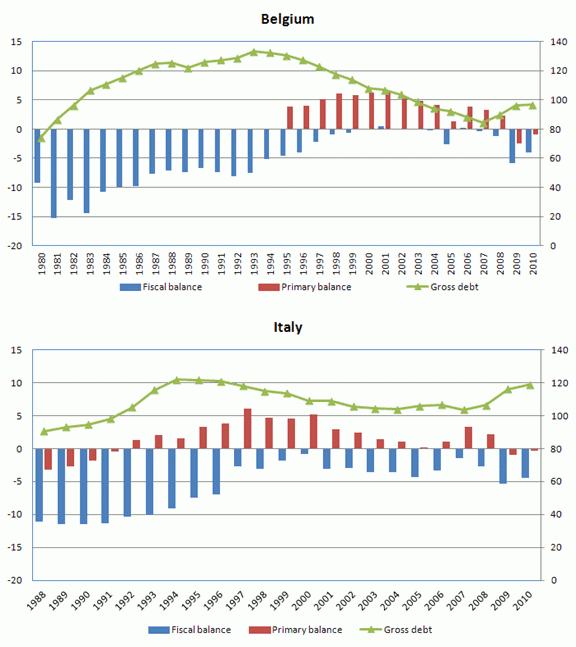As the sovereign debt crisis continues to sweep through the Eurozone, Italy’s public debt is once again at the core of the European economic and political debate. In order to add to such debate, we conduct a simple simulation exercise so as to predict the evolution of the Italian debt-to-GDP ratio. These simulations extend those in the BIS Quarterly Review (2011) by considering multiple scenarios regarding GDP growth and the yield curve.
We find that the debt-to-GDP ratio is sustainable even at the current high interest rates under the assumption of a balanced budget starting in 2014. In the predicted scenarios, however, sustainability crucially depends on a minimum positive growth rate for nominal GDP to occur in the coming years.
Outstanding Italian government bonds
We use data on the outstanding bonds in euros issued by the Italian government on November 2011, which amount to €1.52 trillion or about 95% of the Italian GDP (Ministry of Economy and Finance 2011). We do not include loans and debt of local public authorities that are likely financed at non-market rates (total gross debt is equal to €1.9 trillion or about 120% of GDP).
Fiscal policy assumptions
We assume that the Italian government will be successful in balancing its budget from 2014 onward and will hence run deficits only in 2012 and 2013, which we set to be equal to 2.4% and 1.1% respectively, as estimated by the IMF. In our simulations, starting from 2014, Italy will issue new debt only to roll over outstanding debt coming to maturity. These new issues have the same nominal value and maturity, thereby keeping the maturity structure of public debt unchanged.1
Cost of debt servicing scenarios
We consider three scenarios. In all scenarios, government bonds issued before November 2011 carry an interest rate given by the yield curve as of April 2010. As a result, we suppose that all debt issued before November 2010 was issued at lower, pre-crisis rates. As for the debt issued after November 2011, in the baseline scenario we assume it carries rates that correspond to the yields of April 2010 increased by 100 basis points. In the other two scenarios, all debt issued after November 2011 is financed either at the rates of the yield curve as of April 2010 (best case) or at the highest rates of the yield curve faced by investors on December 2011 (worst case). The worst-case scenario is based on a very conservative assumption, as it implies that the Italian government will pay the current high rates even many years from today, when the debt-to-GDP ratio will be smaller given the assumption of a balanced budget after 2014.
GDP growth scenarios
To conduct a sensitivity analysis, we simulate three different possibilities for the growth rate of GDP in the case of the worst scenario. We use IMF estimates for the nominal GDP growth up to 2016, while we assume a constant annual nominal growth rate for the period 2016–45. In the first possibility, nominal GDP growth is taken to be 3.5%, which corresponds to the average growth rate for the Italian economy in the period spanning the introduction of the euro and the onset of the financial crisis (ie, 2001–07). This nominal growth is compatible with a real annual GDP growth of 1.5% paired with annual inflation of 2%. In the second and third possibilities, nominal GDP grows at the rate of 2.4% (equal to the average annual growth rate of GDP of Germany for the period 2001–07) and 5.2% (equal to the average yearly growth of the US for the period 2001–07), respectively.
Simulations results: Interest payments and outstanding debt
Figure 1 plots the interest payments on debt and the outstanding debt as a percentage of nominal GDP for the period 2012–45 in the worst-case scenario. Nominal post-2016 GDP growth is assumed to be equal to the rate of 3.5%. Interest payments rise rapidly at the beginning of the period up to about 4.5% of GDP and then gradually decline to a value of about 2% in 2045. Since we assume a balanced budget starting in 2014, interest payments after this date correspond to primary surpluses. The debt-to-GDP ratio falls from about 95% of GDP to less than 60% in 2045. Figure 1 also distinguishes between interest payments on debt issued before (blue) and after (red) November 2011. As debt issued before the sovereign crisis matures, new debt is financed at higher rates. Future changes of the yield curve will only affect the payments on the latter (the red bars).
Figure 1.
Simulations results: Different scenarios
Figure 2 and Figure 3 plot the interest payments as a percentage of GDP for different values of GDP growth rates and for different levels of the yield curve. Figure 2 shows that if the yield curve were to revert to the 2010 levels (yield to maturity or YTM 2010: best-case scenario), debt service costs would be lower by about 1% of GDP with respect to the costs under the 2011 levels (YTM 2011: worst-case scenario). The lower debt service costs would still be sizable even if the yield curve were to revert to that of 2010 plus 100 basis points (YTM 2010 + 100bp: baseline scenario).
Figure 2.
Figure 3 highlights the effect of growth on the debt-cost dynamics in the worst-case scenario (ie yield curve as of December 2011). If we set the post-2016 nominal growth rate to 3.5%, the debt service costs in terms of GDP would be approximately 4.5% in 2016 and about 2% in 2045. By setting the GDP nominal growth rate at 2.4% per year, we can capture the effects of low growth. In this case, by 2045 the debt cost would be around its long-run value of 2.9% of GDP. The third possibility considers a higher annual growth rate of 5.4%. In this instance, debt service costs hit the 3% mark just before 2030 and then decline to about 1% by 2045.
Figure 3.
Caveat emptor
The results of our simulations should be interpreted with care. The outcomes are very sensitive to the assumptions of a balanced budget after 2014, constant GDP growth rates after 2016, fixed yield curve for all bond issued after November 2011, and unchanged maturity structure of public debt. These assumptions rule out feedback effects of the austerity measures required to balance the budget on GDP growth. As a result, we exclude the possibility that the austerity measures might backfire and start a vicious circle in which tougher fiscal measures are needed to compensate for lower tax revenues due to the lower GDP growth. Accounting for the effects of fiscal policy is a daunting task that goes beyond the scope of this paper.
Political feasibility of large primary surpluses
A crucial assumption behind the findings of our simulation exercise is that Italy is able to run primary balance surpluses for many years: Italy needs to run primary balances between 4.6% in 2016 and 2.2% in 2045 to stabilise the long-run debt dynamics under the most pessimistic scenario on the interest rates. Whether such political commitment is credible is however an open question, but such large surpluses are not out of reach when compared to the historical values of Italian primary balances. From the Treaty of Maastricht in 1992 and up to the financial crisis of 2007, Italy ran an average annual primary surplus of 2.8% of GDP (see Figure 4). And Italy is not a lone example. Belgium, another EU country with a historically high debt-to-GDP ratio, ran, in the same period, a primary surplus equal to an annual average of 4.8% of GDP. These fiscal efforts helped both countries to reduce their debt-to-GDP ratio: Belgium from about 130% to 84% of GDP; Italy from a peak of about 122% to 104% of GDP.
Figure 4.
Conclusions
To conclude, we look at the evolution of the Italian debt-to-GDP ratio and conclude that it is sustainable even at the current high interest rates. The goal of economic adjustment is within reach, but, as also pointed out by Manasse (2011), requires hard sacrifices in terms of future primary balances. Current high borrowing costs might be motivated by the uncertainty regarding future growth rates and by the potential negative feedback effects of the fiscal measures on economic growth itself.
Disclaimer: The views in this column are those of the authors and do not necessarily represent their affiliated institutions.
References
Bank for International Settlements (2011),BIS Quarterly Review, December .
Ministry of Economy and Finance (2011), Outstanding of public securities: breakdown by maturity, November 2011
International Monetary Fund, “World Economic Outlook”, September 2011
Manasse, Paolo (2011),“Credibility is not everything”, VoxEU.org, 9 November.
1 As for 2012 and 2013, we assume that the Italian Government issues new bonds to finance its budget deficits keeping the market-cap weighted maturity of debt in each year unchanged.









